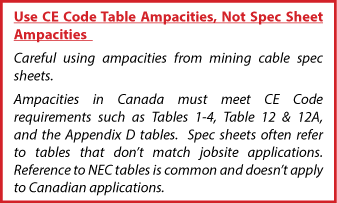This article contains my technical opinions and is for general information purposes only. Product references are generic as different brands and products may have different features.
Mining Cable Introduction
This newsletter builds upon a discussion in my previous newsletter on SHD-GC cables, providing an introduction to some of the other power cables commonly used in Canadian Mining Projects. Each product has unique advantages and disadvantages for use. Sometimes it is the specific application that determines the cable to use, other times the final decision is influenced by what is available in stock in the quantities and gauge size required.
Typical Mining Cables
HVTECK – This shielded cable type is commonly used for 5KV to 35KV power applications. It is an interlock armored robust product rated for almost all applications used in a mine. It is commonly used to supply power to load center via vertical drops down mine shafts and surface applications on cable tray, direct buried, or in underground duct banks.

Vertical Riser Teck – Available in 600V to 35KV. Typically used for vertical applications. It is similar to an HVTECK or Teck90 cable with manufacturer specific additional features allowing for longer unsupported vertical applications. Interlock armored for additional mechanical protection. Different versions have different maximum unsupported vertical length allowances.

MPF – This is a flexible 5KV to 35KV cable typically used underground both for vertical and horizontal runs. MPF is attached to a messenger for vertical applications. MPF cables are an excellent & economical product when used for permanent or fixed applications underground when mounted during the tunnel’s descent.


Airguard – This is a very robust cable used in Canada for 5KV to 35KV underground and surface mining power distribution including vertical applications. These products provide three to five times more mechanical protection than metal armored cables and are excellent when used to ward off sidewall pressure concerns during a long haul runs.

Teck90 – Unshielded interlock armored cables in 600V, 1KV and 5KV versions. This is a standard surface power distribution cable for both permanent and temporary applications.

G-GC – This is an unshielded flexible cable commonly used in Canada for portable or temporary applications up to 2kV. Typical constructions have 3 EPR insulated conductors, 1 ground check conductor, 2 bare grounds, and a CPE jacket.

Type W – Similar to a G-GC but with no ground check conductor and a full sized green ground. Available with 1, 3 or 4 EPR insulated conductors and a CPE jacket.

SHD-GC – Robust and highly flexible available in 2KV to 35KV versions. These cables are commonly used to power mobile mining equipment or portable equipment applications over 300V. They are shielded cables with a ground check conductor providing additional electrical safety for harsh wet conditions. Typical construction have 3 shielded EPR insulated conductors, 1 ground check conductor, 2 bare grounds, and a CPE or TPU jacket.


Portable applications – These cables are not CE Code approved for permanent applications unless they are additionally CSA TC rated. They are typically used for powering portable mining equipment like continuous miners, drills, and pumps. Many of these cables are rated for shallow water submersion.
SOOW – These are light duty cords often used in mines for temporary applications.

There are many kinds and options of power cables used in Mining Applications. At Texcan, we can supply these products with approved male & female couplers & putty compounds installed for custom applications.
Don’t hesitate to contact Texcan for more detailed information on your specific applications and requirements.

If you found this article helpful, consider signing up for our email newsletter for technical product information, new products, and more — SIGN UP TODAY. For more information read our Mining Industry Flyer HERE.

